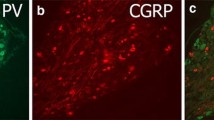Abstract
The axotomy reaction in motoneurons after a peripheral nerve transection in the adult animal is characterized by a robust upregulation of alpha-calcitonin gene-related peptide (CGRP) messenger RNA (mRNA) together with mRNAs encoding cytoskeletal and growth-related proteins. Here we have examined whether the nature of the lesion and the age of the animal have any impact on the mRNA regulation in severed cells. Thus, the effect of a sciatic nerve transection in the adult rat was compared with, on the one hand, ventral root avulsions in the adult animal and, on the other hand, sciatic nerve transection in the immature animal. In the two latter cases, a proportion of the lesioned cells die and overall chances of regeneration are small. In the adult animal a sciatic nerve transection induced an upregulation of alpha-CGRP mRNA from the 3rd day after surgery and throughout the first 3 weeks (the time span of the study). Also low-affinity nerve growth factor receptor (p75) and growth-associated protein-43 (GAP-43) mRNAs were upregulated during the entire 3-week period. In contrast, after ventral root avulsion, the expression of alpha-CGRP, c-jun, and p75 mRNAs were normalized within the 1st postoperative week, while GAP-43 mRNA was still upregulated at 3 weeks. Galanin message-associated peptide (GMAP) mRNA became upregulated preferentially in motoneurons subjected to ventral root avulsion, while nitric oxide synthase (NOS) mRNA was expressed exclusively after the latter type of injury. In the immature animal, alpha-CGRP mRNA was downregulated after sciatic nerve transection in rats aged 3 days or 7 days at the time of surgery; while, in contrast, an upregulation was seen in 12- or 21-day-old animals. GAP-43 and c-jun mRNAs were upregulated in lesioned motoneurons of all ages, while GMAP mRNA was upregulated preferentially in lesioned motoneurons of early postnatal animals. p75 mRNA was expressed in unlesioned immature motoneurons until the age of 7–10 days. The downregulation of p75 mRNA in intact cells at this age coincided with a developmental switch in the ability of axotomized cells to express increased levels of p75 mRNA. No expression of NOS mRNA was detectable in lesioned cells of any of the age groups. These results show that the age of the animal and the type of axonal injury are indeed to a high degree influencing the changes seen in the protein expression pattern in axotomized rat motoneurons. The different responses in these paradigms suggest differences in the trophic response from surrounding glia or the trophic responsiveness of lesioned motoneurons. Also, the results may indicate different roles for the studied substances during the regenerative response of lesioned neurons. Of the substances studied here, upregulation of alpha-CGRP and p75 mRNAs best correlated with a possibility of axon regeneration.
Similar content being viewed by others
Author information
Authors and Affiliations
Additional information
Received: 11 December 1996 / Accepted: 16 September 1997
Rights and permissions
About this article
Cite this article
Piehl, F., Hammarberg, H., Tabar, G. et al. Changes in the mRNA expression pattern, with special reference to calcitonin gene-related peptide, after axonal injuries in rat motoneurons depends on age and type of injury. Exp Brain Res 119, 191–204 (1998). https://doi.org/10.1007/s002210050333
Issue Date:
DOI: https://doi.org/10.1007/s002210050333




